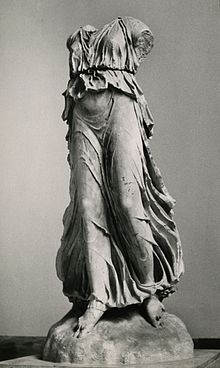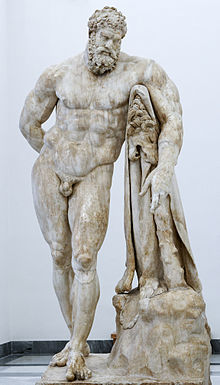Farnese collections
The Farnese Collections are important and well-known collections of art treasures and antiques from antiquity and the Renaissance , which the Farnese family brought together in the Palazzo Farnese in Rome from the 16th century onwards.
history
Building the collection
Pope Paul III (real name Alessandro Farnese) founded the collection when he issued an edict granting his family permission for excavations and an exclusive right to the sculptures found. The aim was to be able to decorate his main residence, the Palazzo Farnese , with objects of art, stone and marble. The foundations were mainly laid during excavations in the Roman Caracalla baths in the 1540s. His grandson, Cardinal Alessandro Farnese the Younger , an important patron of the arts, drove the further development of the Farnese collections . Through his efforts, they grew to over 400 sculptures and other objects of art ( gems , paintings, drawings, books). The humanist, librarian and antiquarian Fulvio Orsini provided advisory services .
The majority of the objects were used as decorations in the Palazzo Farnese, in the archways and reception rooms, in the courtyards and in the garden; however, numerous others that were considered less important were also kept in other family residences. These were the Palazzo Farnese in Caprarola , the Ducal Palace in Colorno, as well as the Villa Madama , the Villa Farnesina and the Farnesin Gardens in Rome.
Paul III established the Duchy of Parma in 1545 for his illegitimate son Pier Luigi Farnese . The members of the line of Dukes of Parma founded by Pier Luigi also accumulated numerous art treasures. For this they also confiscated the property of the nobles who were involved in the rebellion of 1611. The pieces were mainly collected in the Palace of Colorno, the residence of the Dukes of Parma.
Another story
When the family died out with the death of Antonio Farnese in 1731, the collection was dispersed. A part went to the Spanish king Philip V from the house of the Bourbons , since his wife Elisabetta Farnese (1692–1766) was Antonio's niece and thus heiress. Her eldest son Karl (1716–1788), who later (from 1759) was named Karl III. also became king of Spain, ruled from 1734 to 1739 as king of Naples and Sicily . In this way, the works of art that had previously been in the possession of the Dukes of Parma reached Naples. Charles' third son Ferdinand followed him in the Italian Empire and, after lengthy controversies, reached Pope Pius VI in 1786/7 . that the works of art of the Farnese that remained in Rome could also be brought to the Palazzo Reale in Naples. The landscape painter Jakob Philipp Hackert and the Marchese Domenico Venuti , of whom the latter inventoried the collection in 1786, were responsible for handling this transport . The last time this happened was in 1767 and 1775.
In 1826 the Farnese collections came to the Museo Archeologico Nazionale (National Archaeological Museum of Naples), which had been founded in 1787 and made numerous previously private art collections the basis of its holdings in the decades that followed.
Famous works of art in the collections

The most important pieces in the Farnese collections include Roman copies of Greek works of art found mainly in the Baths of Caracalla, especially
- the Farnesian Hercules, excavated in 1546 (copy with signature of the Glycon of Athens , whose model is presumably a statue of Lysippus ) - one of the most famous sculptures of antiquity, which established the image of Hercules in the European imagination.
- the Farnesian bull , excavated in 1545 , whose model was Apollonios of Tralleis and Tauriskos of Tralleis around 50 BC. Chr. Made. This work of art is mentioned by Pliny the Elder in his natural history .
- the Atlas Farnese , the Roman copy of a Hellenistic original
- the Tazza Farnese , a Hellenistic stone carving
In the Ducal Palace of Colorno is also were two colossal statues of basalt , the Hercules and Dionysus represent and the Abbot Francesco Bianchini near the imperial palaces on the Palatine was found.
Other components of the collection are works of art from the Renaissance, including works by Titian , Raphael , Michelangelo and El Greco, as well as by Guglielmo della Porta , the Farnese court painter who also added the Farnese Hercules, Andrea Mantegna and Sebastiano del Piombo . The miniature painter Giulio Clovio bequeathed 401 drawings to Alessandro Farnese the Younger before his death in 1577, which more than doubled the number of sheets in the collection - in 1588 only 257 sheets were not by Clovio, but by at least 17 different other artists. Later, however, numerous drawings by Clovio were mistakenly attributed to more famous painters such as Michelangelo.
literature
- Archivio Fotografico Pedicini (ed.): Le collezioni del Museo Nazionale di Napoli. Volume 2: Renata Cantilena: La scultura greco-romana, le sculture antiche della collezione farnese, le collezioni monetali, le oreficerie, la collezione glittica (= Le grandi collezioni dei musei italiani. 1, 2). De Luca, Rome 1989, ISBN 88-7813-214-4 .
- Christina Riebesell: The Collection of Cardinal Alessandro Farnese. A "studio" for artists and scholars. VCH - Acta Humaniora, Weinheim 1989, ISBN 3-527-17656-X (also: Hamburg, University, dissertation, 1986).
- Steffi Oehmke: Disarming love. On the iconology of Herakles / Omphale images based on the Naples-Copenhagen group. In: Yearbook of the German Archaeological Institute. Vol. 115, 2000, ISSN 0931-7007 , pp. 147-198, especially pp. 150 f. ( partly online at Google Books ).
- Carlo Gasparri (Ed.): La collezione Farnese. Electa, Naples 2009, ISBN 978-88-510-0601-3 .
- the national archaeological museum of naples. guide. Electa, Naples 2009, ISBN 978-88-510-0590-0 , p. 1, (reprint of the 2009 edition: ibid 2011).
Individual evidence
- ↑ Steffi Oehmke ( Disarming love. On the iconology of Herakles / Omphale images based on the Naples-Copenhagen group. In: Yearbook of the German Archaeological Institute. Vol. 115, 2000, pp. 147–198, here p. 150.) gives 1786 the guide of the Naples Archaeological Museum (2011 edition, p. 18.) names 1787 as the year of permission.
- ↑ Alexander Perrig : Cellini as a draftsman or: The return of his leaves left in Paris. In: Alessandro Nova , Anna Schreurs (Ed.): Benvenuto Cellini. Art and Art Theory in the 16th Century. Böhlau, Cologne et al. 2003, ISBN 3-412-11002-7 , pp. 125–160, here p. 130, ( online at Google Books ).

